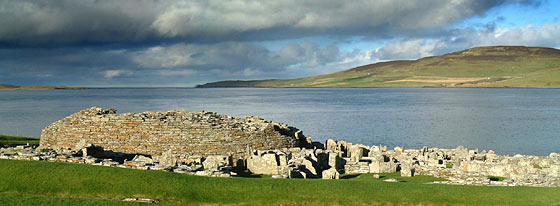
 |
 |
| Home |
| About Orkney |
| History |
| Tradition |
| Folklore |
| Placenames |
| Images |
| Downloads |
| About the Site |
| Contact |
| Links |
| Search Site |
| Awards |
| Orkney's Brochs | |
|
The Broch of Gurness, Evie
Until the summer of 1929, the site of the Broch of Gurness was nothing more than a massive, grassy mound by the shore. The mound was known as the Knowe o' Aikerness. The Knowe o' Aikerness The remains of the broch were discovered by Orcadian poet and antiquarian, Robert Rendall. While sketching on the knowe, one of the legs of Rendall's stool sank into the mound. Carefully removing some of the nearby stones, Rendall uncovered a staircase leading down into the mound. Full excavations began later that year and, for the first time in centuries, the broch and its outbuildings saw the light of day.
Dates for the broch are unclear, but it is generally agreed that it was built between 200BC and 100BC - possibly on the site of an earlier settlement. Standing around eight metres high (26 feet), with an internal diameter of 20 metres (65 feet), the broch was a tall, easily-defended, tower, surrounded by a series of small stone dwellings. The entire settlement was circled by outer defences comprising of a band of three ramparts and three ditches. The sprawl of stone houses filled all the available space between broch and the outer defences, and probably housed a community of up to 40 families. The semi-detached stone-built dwellings were partitioned off into separate living areas, each contained a hearth, stone furniture, and even a recognisable toilet. The broch itself was accessed by an entrance causeway on the eastern side of the settlement. Houses line this causeway giving the appearance of a processional path. As time progressed, the broch's defensive role decreased, until around 100AD, after years of neglect, it was finally abandoned and its upper sections dismantled - probably to provide the building material for later houses in the area. Over the ensuing years, its walls continued to be reduced, as stone provided a valuable source of building material. The structure that remains today is, at its maximum, 3.5 metres tall, with a solid base. The hollow section of the wall, on either side of the main entrance, houses small cells. Underground cellar
During the years of its occupation, a number of alterations were made to the interior of the broch but the original rectangular hearth and an underground chamber containing a spring-filled water tank are still clearly visible today. This chamber, typical of a number found at sites across Orkney, is very similar to the underground chamber discovered at Minehowe in 1946. Pictish developments With the broch abandoned, the village also fell out of use, as the population decreased, or drifted away to settle elsewhere. As a result, the village was either demolished or gradually flattened over time. By the fifth century AD, when Orkney was part of the Pictish nation, Aikerness was still being used, but for a series small houses or farms. The most striking of these houses can still be seen upon entering the site today. The "Shamrock House", as it has been christened, is typically Pictish in design, and was found buried in the rubble on the south-eastern part of the site. It was subsequently moved, stone by stone, to the right of the modern entrance. Other Pictish finds from Gurness included an ogham-inscribed bone knife handle and a stone carved with Pictish symbols. The fragmented remains of a Pictish symbol stone were uncovered on the nearby sands of Evie. Viking occupation Aikerness was one of the many Pictish sites in Orkney taken over by the Norse when they arrived in the islands. By the time they settled in Orkney, there was probably nothing at the Gurness site, other than a grassy mound. It is possible that the mound held some significance to the pagan Norse settlers - who had a tradition of burying their dead in mounds - with at least one Viking grave found on site. The female grave, containing typical Scandinavian brooches, was found dug into the old rampart surrounding the settlement. The remains of a large rectangular structure also led to the suggestion that there may have been a Norse hall at Aikerness. The truth of the matter is, however, that the structure could also be Pictish as other evidence uncovered has been inconclusive. After the Norse burial, the Gurness site seems to have been left alone, with no other evidence of later disturbance or development, until the 1929 excavation. |
The remains of the Broch of Gurness are found on an north-eastern shore of the Orkney Mainland, at a place known as Aikerness, in the parish of Evie. Overlooking the body of water known as Eynhallow Sound, the site offers spectacular views across to the uninhabited island of Eynhallow and the larger, hilly, island of Rousay. Given the defensive nature of the broch, a visitor can immediately understand the strategic positioning of the structure. "Aikerness" derives from the Old Norse "Akr-nes" meaning "Arable Point". I am not certain at which point the broch became known as "Gurness" but suspect this is the result of another mistake relating the recording of Orcadian dialect. Throughout the records of the broch's excavation, it is only ever referred to as "The Broch of Aikerness". "Aikerness" is pronounced something like "Eh - cur-nis", with the emphasis on the last two syllables. Could it be that the archaeologist who documented the site misheard or did not understand the Orcadian tongue? In its later years, the broch tower had a porch-like structure added to the sole entrance. The remains of this structure can still be seen today. |



